YOLOv4: Optimal Speed and Accuracy of Object Detection
Alexey Bochkovskiy∗
alexeyab84@gmail.com
Chien-Yao Wang∗
Hong-Yuan Mark Liao
Institute of Information Science
Institute of Information Science
Academia Sinica, Taiwan
kinyiu@iis.sinica.edu.tw
Academia Sinica, Taiwan
liao@iis.sinica.edu.tw
0
2
0
2
r
p
A
3
2
]
V
C
.
s
c
[
1
v
4
3
9
0
1
.
4
0
0
2
:
v
i
X
r
a
Abstract
There are a huge number of features which are said to
improve Convolutional Neural Network (CNN) accuracy.
Practical testing of combinations of such features on large
datasets, and theoretical justification of the result, is re-
quired. Some features operate on certain models exclusively
and for certain problems exclusively, or only for small-scale
datasets; while some features, such as batch-normalization
and residual-connections, are applicable to the majority of
models, tasks, and datasets. We assume that such universal
features include Weighted-Residual-Connections (WRC),
Cross-Stage-Partial-connections (CSP), Cross mini-Batch
Normalization (CmBN), Self-adversarial-training (SAT)
and Mish-activation. We use new features: WRC, CSP,
CmBN, SAT, Mish activation, Mosaic data augmentation,
CmBN, DropBlock regularization, and CIoU loss, and com-
bine some of them to achieve state-of-the-art results: 43.5%
AP (65.7% AP50) for the MS COCO dataset at a real-
time speed of ∼65 FPS on Tesla V100. Source code is at
https://github.com/AlexeyAB/darknet.
1. Introduction
The majority of CNN-based object detectors are largely
applicable only for recommendation systems. For example,
searching for free parking spaces via urban video cameras
is executed by slow accurate models, whereas car collision
warning is related to fast inaccurate models.
Improving
the real-time object detector accuracy enables using them
not only for hint generating recommendation systems, but
also for stand-alone process management and human input
reduction. Real-time object detector operation on conven-
tional Graphics Processing Units (GPU) allows their mass
usage at an affordable price. The most accurate modern
neural networks do not operate in real time and require large
number of GPUs for training with a large mini-batch-size.
We address such problems through creating a CNN that op-
erates in real-time on a conventional GPU, and for which
training requires only one conventional GPU.
Figure 1: Comparison of the proposed YOLOv4 and other
state-of-the-art object detectors. YOLOv4 runs twice faster
than EfficientDet with comparable performance. Improves
YOLOv3’s AP and FPS by 10% and 12%, respectively.
The main goal of this work is designing a fast operating
speed of an object detector in production systems and opti-
mization for parallel computations, rather than the low com-
putation volume theoretical indicator (BFLOP). We hope
that the designed object can be easily trained and used. For
example, anyone who uses a conventional GPU to train and
test can achieve real-time, high quality, and convincing ob-
ject detection results, as the YOLOv4 results shown in Fig-
ure 1. Our contributions are summarized as follows:
1. We develope an efficient and powerful object detection
model. It makes everyone can use a 1080 Ti or 2080 Ti
GPU to train a super fast and accurate object detector.
2. We verify the influence of state-of-the-art Bag-of-
Freebies and Bag-of-Specials methods of object detec-
tion during the detector training.
3. We modify state-of-the-art methods and make them
more effecient and suitable for single GPU training,
including CBN [89], PAN [49], SAM [85], etc.
1
�
Figure 2: Object detector.
2. Related work
2.1. Object detection models
A modern detector is usually composed of two parts,
a backbone which is pre-trained on ImageNet and a head
which is used to predict classes and bounding boxes of ob-
jects. For those detectors running on GPU platform, their
backbone could be VGG [68], ResNet [26], ResNeXt [86],
or DenseNet [30]. For those detectors running on CPU plat-
form, their backbone could be SqueezeNet [31], MobileNet
[28, 66, 27, 74], or ShuffleNet [97, 53]. As to the head part,
it is usually categorized into two kinds, i.e., one-stage object
detector and two-stage object detector. The most represen-
tative two-stage object detector is the R-CNN [19] series,
including fast R-CNN [18], faster R-CNN [64], R-FCN [9],
and Libra R-CNN [58]. It is also possible to make a two-
stage object detector an anchor-free object detector, such as
RepPoints [87]. As for one-stage object detector, the most
representative models are YOLO [61, 62, 63], SSD [50],
and RetinaNet [45]. In recent years, anchor-free one-stage
object detectors are developed. The detectors of this sort are
CenterNet [13], CornerNet [37, 38], FCOS [78], etc. Object
detectors developed in recent years often insert some lay-
ers between backbone and head, and these layers are usu-
ally used to collect feature maps from different stages. We
can call it the neck of an object detector. Usually, a neck
is composed of several bottom-up paths and several top-
down paths. Networks equipped with this mechanism in-
clude Feature Pyramid Network (FPN) [44], Path Aggrega-
tion Network (PAN) [49], BiFPN [77], and NAS-FPN [17].
2
In addition to the above models, some researchers put their
emphasis on directly building a new backbone (DetNet [43],
DetNAS [7]) or a new whole model (SpineNet [12], HitDe-
tector [20]) for object detection.
To sum up, an ordinary object detector is composed of
several parts:
• Input: Image, Patches, Image Pyramid
• Backbones: VGG16 [68], ResNet-50 [26], SpineNet
[12], EfficientNet-B0/B7 [75], CSPResNeXt50 [81],
CSPDarknet53 [81]
• Neck:
• Additional blocks: SPP [25], ASPP [5], RFB
[47], SAM [85]
• Path-aggregation blocks: FPN [44], PAN [49],
NAS-FPN [17], Fully-connected FPN, BiFPN
[77], ASFF [48], SFAM [98]
• Heads::
• Dense Prediction (one-stage):
◦ RPN [64], SSD [50], YOLO [61], RetinaNet
◦ CornerNet [37], CenterNet [13], MatrixNet
[45] (anchor based)
[60], FCOS [78] (anchor free)
• Sparse Prediction (two-stage):
◦ Faster R-CNN [64], R-FCN [9], Mask R-
◦ RepPoints [87] (anchor free)
CNN [23] (anchor based)
�
2.2. Bag of freebies
Usually, a conventional object detector is trained off-
line. Therefore, researchers always like to take this advan-
tage and develop better training methods which can make
the object detector receive better accuracy without increas-
ing the inference cost. We call these methods that only
change the training strategy or only increase the training
cost as “bag of freebies.” What is often adopted by object
detection methods and meets the definition of bag of free-
bies is data augmentation. The purpose of data augmenta-
tion is to increase the variability of the input images, so that
the designed object detection model has higher robustness
to the images obtained from different environments. For
examples, photometric distortions and geometric distortions
are two commonly used data augmentation method and they
definitely benefit the object detection task. In dealing with
photometric distortion, we adjust the brightness, contrast,
hue, saturation, and noise of an image. For geometric dis-
tortion, we add random scaling, cropping, flipping, and ro-
tating.
The data augmentation methods mentioned above are all
pixel-wise adjustments, and all original pixel information in
the adjusted area is retained. In addition, some researchers
engaged in data augmentation put their emphasis on sim-
ulating object occlusion issues. They have achieved good
results in image classification and object detection. For ex-
ample, random erase [100] and CutOut [11] can randomly
select the rectangle region in an image and fill in a random
or complementary value of zero. As for hide-and-seek [69]
and grid mask [6], they randomly or evenly select multiple
rectangle regions in an image and replace them to all ze-
ros. If similar concepts are applied to feature maps, there
are DropOut [71], DropConnect [80], and DropBlock [16]
methods. In addition, some researchers have proposed the
methods of using multiple images together to perform data
augmentation. For example, MixUp [92] uses two images
to multiply and superimpose with different coefficient ra-
tios, and then adjusts the label with these superimposed ra-
tios. As for CutMix [91], it is to cover the cropped image
to rectangle region of other images, and adjusts the label
according to the size of the mix area.
In addition to the
above mentioned methods, style transfer GAN [15] is also
used for data augmentation, and such usage can effectively
reduce the texture bias learned by CNN.
Different from the various approaches proposed above,
some other bag of freebies methods are dedicated to solving
the problem that the semantic distribution in the dataset may
have bias. In dealing with the problem of semantic distri-
bution bias, a very important issue is that there is a problem
of data imbalance between different classes, and this prob-
lem is often solved by hard negative example mining [72]
or online hard example mining [67] in two-stage object de-
tector. But the example mining method is not applicable
3
to one-stage object detector, because this kind of detector
belongs to the dense prediction architecture. Therefore Lin
et al.
[45] proposed focal loss to deal with the problem
of data imbalance existing between various classes. An-
other very important issue is that it is difficult to express the
relationship of the degree of association between different
categories with the one-hot hard representation. This rep-
resentation scheme is often used when executing labeling.
The label smoothing proposed in [73] is to convert hard la-
bel into soft label for training, which can make model more
robust. In order to obtain a better soft label, Islam et al. [33]
introduced the concept of knowledge distillation to design
the label refinement network.
The last bag of freebies is the objective function of
Bounding Box (BBox) regression. The traditional object
detector usually uses Mean Square Error (MSE) to di-
rectly perform regression on the center point coordinates
and height and width of the BBox, i.e., {xcenter, ycenter,
w, h}, or the upper left point and the lower right point,
i.e., {xtop lef t, ytop lef t, xbottom right, ybottom right}. As
for anchor-based method, it is to estimate the correspond-
for example {xcenter of f set, ycenter of f set,
ing offset,
wof f set, hof f set} and {xtop lef t of f set, ytop lef t of f set,
xbottom right of f set, ybottom right of f set}. However, to di-
rectly estimate the coordinate values of each point of the
BBox is to treat these points as independent variables, but
in fact does not consider the integrity of the object itself. In
order to make this issue processed better, some researchers
recently proposed IoU loss [90], which puts the coverage of
predicted BBox area and ground truth BBox area into con-
sideration. The IoU loss computing process will trigger the
calculation of the four coordinate points of the BBox by ex-
ecuting IoU with the ground truth, and then connecting the
generated results into a whole code. Because IoU is a scale
invariant representation, it can solve the problem that when
traditional methods calculate the l1 or l2 loss of {x, y, w,
h}, the loss will increase with the scale. Recently, some
researchers have continued to improve IoU loss. For exam-
ple, GIoU loss [65] is to include the shape and orientation
of object in addition to the coverage area. They proposed to
find the smallest area BBox that can simultaneously cover
the predicted BBox and ground truth BBox, and use this
BBox as the denominator to replace the denominator origi-
nally used in IoU loss. As for DIoU loss [99], it additionally
considers the distance of the center of an object, and CIoU
loss [99], on the other hand simultaneously considers the
overlapping area, the distance between center points, and
the aspect ratio. CIoU can achieve better convergence speed
and accuracy on the BBox regression problem.
�
2.3. Bag of specials
For those plugin modules and post-processing methods
that only increase the inference cost by a small amount
but can significantly improve the accuracy of object detec-
tion, we call them “bag of specials”. Generally speaking,
these plugin modules are for enhancing certain attributes in
a model, such as enlarging receptive field, introducing at-
tention mechanism, or strengthening feature integration ca-
pability, etc., and post-processing is a method for screening
model prediction results.
Common modules that can be used to enhance recep-
tive field are SPP [25], ASPP [5], and RFB [47]. The
SPP module was originated from Spatial Pyramid Match-
ing (SPM) [39], and SPMs original method was to split fea-
ture map into several d × d equal blocks, where d can be
{1, 2, 3, ...}, thus forming spatial pyramid, and then extract-
ing bag-of-word features. SPP integrates SPM into CNN
and use max-pooling operation instead of bag-of-word op-
eration. Since the SPP module proposed by He et al. [25]
will output one dimensional feature vector, it is infeasible to
be applied in Fully Convolutional Network (FCN). Thus in
the design of YOLOv3 [63], Redmon and Farhadi improve
SPP module to the concatenation of max-pooling outputs
with kernel size k × k, where k = {1, 5, 9, 13}, and stride
equals to 1. Under this design, a relatively large k × k max-
pooling effectively increase the receptive field of backbone
feature. After adding the improved version of SPP module,
YOLOv3-608 upgrades AP50 by 2.7% on the MS COCO
object detection task at the cost of 0.5% extra computation.
The difference in operation between ASPP [5] module and
improved SPP module is mainly from the original k×k ker-
nel size, max-pooling of stride equals to 1 to several 3 × 3
kernel size, dilated ratio equals to k, and stride equals to 1
in dilated convolution operation. RFB module is to use sev-
eral dilated convolutions of k×k kernel, dilated ratio equals
to k, and stride equals to 1 to obtain a more comprehensive
spatial coverage than ASPP. RFB [47] only costs 7% extra
inference time to increase the AP50 of SSD on MS COCO
by 5.7%.
The attention module that is often used in object detec-
tion is mainly divided into channel-wise attention and point-
wise attention, and the representatives of these two atten-
tion models are Squeeze-and-Excitation (SE) [29] and Spa-
tial Attention Module (SAM) [85], respectively. Although
SE module can improve the power of ResNet50 in the Im-
ageNet image classification task 1% top-1 accuracy at the
cost of only increasing the computational effort by 2%, but
on a GPU usually it will increase the inference time by
about 10%, so it is more appropriate to be used in mobile
devices. But for SAM, it only needs to pay 0.1% extra cal-
culation and it can improve ResNet50-SE 0.5% top-1 accu-
racy on the ImageNet image classification task. Best of all,
it does not affect the speed of inference on the GPU at all.
In terms of feature integration, the early practice is to use
skip connection [51] or hyper-column [22] to integrate low-
level physical feature to high-level semantic feature. Since
multi-scale prediction methods such as FPN have become
popular, many lightweight modules that integrate different
feature pyramid have been proposed. The modules of this
sort include SFAM [98], ASFF [48], and BiFPN [77]. The
main idea of SFAM is to use SE module to execute channel-
wise level re-weighting on multi-scale concatenated feature
maps. As for ASFF, it uses softmax as point-wise level re-
weighting and then adds feature maps of different scales.
In BiFPN, the multi-input weighted residual connections is
proposed to execute scale-wise level re-weighting, and then
add feature maps of different scales.
In the research of deep learning, some people put their
focus on searching for good activation function. A good
activation function can make the gradient more efficiently
propagated, and at the same time it will not cause too
much extra computational cost.
In 2010, Nair and Hin-
ton [56] propose ReLU to substantially solve the gradient
vanish problem which is frequently encountered in tradi-
tional tanh and sigmoid activation function. Subsequently,
LReLU [54], PReLU [24], ReLU6 [28], Scaled Exponential
Linear Unit (SELU) [35], Swish [59], hard-Swish [27], and
Mish [55], etc., which are also used to solve the gradient
vanish problem, have been proposed. The main purpose of
LReLU and PReLU is to solve the problem that the gradi-
ent of ReLU is zero when the output is less than zero. As
for ReLU6 and hard-Swish, they are specially designed for
quantization networks. For self-normalizing a neural net-
work, the SELU activation function is proposed to satisfy
the goal. One thing to be noted is that both Swish and Mish
are continuously differentiable activation function.
The post-processing method commonly used in deep-
learning-based object detection is NMS, which can be used
to filter those BBoxes that badly predict the same ob-
ject, and only retain the candidate BBoxes with higher re-
sponse. The way NMS tries to improve is consistent with
the method of optimizing an objective function. The orig-
inal method proposed by NMS does not consider the con-
text information, so Girshick et al. [19] added classification
confidence score in R-CNN as a reference, and according to
the order of confidence score, greedy NMS was performed
in the order of high score to low score. As for soft NMS [1],
it considers the problem that the occlusion of an object may
cause the degradation of confidence score in greedy NMS
with IoU score. The DIoU NMS [99] developers way of
thinking is to add the information of the center point dis-
tance to the BBox screening process on the basis of soft
NMS. It is worth mentioning that, since none of above post-
processing methods directly refer to the captured image fea-
tures, post-processing is no longer required in the subse-
quent development of an anchor-free method.
4
�
Table 1: Parameters of neural networks for image classification.
Backbone model
Input network
resolution
Receptive
field size
Parameters
CSPResNext50
CSPDarknet53
EfficientNet-B3 (ours)
512x512
512x512
512x512
425x425
725x725
1311x1311
20.6 M
27.6 M
12.0 M
Average size
of layer output
(WxHxC)
1058 K
950 K
668 K
BFLOPs
(512x512 network resolution)
FPS
(GPU RTX 2070)
31 (15.5 FMA)
52 (26.0 FMA)
11 (5.5 FMA)
62
66
26
3. Methodology
The basic aim is fast operating speed of neural network,
in production systems and optimization for parallel compu-
tations, rather than the low computation volume theoreti-
cal indicator (BFLOP). We present two options of real-time
neural networks:
• For GPU we use a small number of groups (1 - 8) in
convolutional layers: CSPResNeXt50 / CSPDarknet53
• For VPU - we use grouped-convolution, but we re-
frain from using Squeeze-and-excitement (SE) blocks
- specifically this includes the following models:
EfficientNet-lite / MixNet [76] / GhostNet [21] / Mo-
bileNetV3
3.1. Selection of architecture
Our objective is to find the optimal balance among the in-
put network resolution, the convolutional layer number, the
parameter number (filter size2 * filters * channel / groups),
and the number of layer outputs (filters). For instance, our
numerous studies demonstrate that the CSPResNext50 is
considerably better compared to CSPDarknet53 in terms
of object classification on the ILSVRC2012 (ImageNet)
dataset [10]. However, conversely, the CSPDarknet53 is
better compared to CSPResNext50 in terms of detecting ob-
jects on the MS COCO dataset [46].
The next objective is to select additional blocks for in-
creasing the receptive field and the best method of parame-
ter aggregation from different backbone levels for different
detector levels: e.g. FPN, PAN, ASFF, BiFPN.
A reference model which is optimal for classification is
not always optimal for a detector. In contrast to the classi-
fier, the detector requires the following:
• Higher input network size (resolution) – for detecting
multiple small-sized objects
• More layers – for a higher receptive field to cover the
increased size of input network
• More parameters – for greater capacity of a model to
detect multiple objects of different sizes in a single im-
age
Hypothetically speaking, we can assume that a model
with a larger receptive field size (with a larger number of
convolutional layers 3 × 3) and a larger number of parame-
ters should be selected as the backbone. Table 1 shows the
information of CSPResNeXt50, CSPDarknet53, and Effi-
cientNet B3. The CSPResNext50 contains only 16 convo-
lutional layers 3 × 3, a 425 × 425 receptive field and 20.6
M parameters, while CSPDarknet53 contains 29 convolu-
tional layers 3 × 3, a 725 × 725 receptive field and 27.6
M parameters. This theoretical justification, together with
our numerous experiments, show that CSPDarknet53 neu-
ral network is the optimal model of the two as the backbone
for a detector.
The influence of the receptive field with different sizes is
summarized as follows:
• Up to the object size - allows viewing the entire object
• Up to network size - allows viewing the context around
the object
• Exceeding the network size - increases the number of
connections between the image point and the final ac-
tivation
We add the SPP block over the CSPDarknet53, since it
significantly increases the receptive field, separates out the
most significant context features and causes almost no re-
duction of the network operation speed. We use PANet as
the method of parameter aggregation from different back-
bone levels for different detector levels, instead of the FPN
used in YOLOv3.
Finally, we choose CSPDarknet53 backbone, SPP addi-
tional module, PANet path-aggregation neck, and YOLOv3
(anchor based) head as the architecture of YOLOv4.
In the future we plan to expand significantly the content
of Bag of Freebies (BoF) for the detector, which theoreti-
cally can address some problems and increase the detector
accuracy, and sequentially check the influence of each fea-
ture in an experimental fashion.
We do not use Cross-GPU Batch Normalization (CGBN
or SyncBN) or expensive specialized devices. This al-
lows anyone to reproduce our state-of-the-art outcomes on
a conventional graphic processor e.g. GTX 1080Ti or RTX
2080Ti.
5
�
3.2. Selection of BoF and BoS
For improving the object detection training, a CNN usu-
ally uses the following:
• Activations: ReLU, leaky-ReLU, parametric-ReLU,
ReLU6, SELU, Swish, or Mish
• Bounding box regression loss: MSE, IoU, GIoU,
CIoU, DIoU
• Data augmentation: CutOut, MixUp, CutMix
• Regularization method: DropOut, DropPath [36],
Spatial DropOut [79], or DropBlock
• Normalization of the network activations by their
mean and variance: Batch Normalization (BN) [32],
Cross-GPU Batch Normalization (CGBN or SyncBN)
[93], Filter Response Normalization (FRN) [70], or
Cross-Iteration Batch Normalization (CBN) [89]
• Skip-connections: Residual connections, Weighted
residual connections, Multi-input weighted residual
connections, or Cross stage partial connections (CSP)
As for training activation function, since PReLU and
SELU are more difficult to train, and ReLU6 is specifically
designed for quantization network, we therefore remove the
above activation functions from the candidate list. In the
method of reqularization, the people who published Drop-
Block have compared their method with other methods in
detail, and their regularization method has won a lot. There-
fore, we did not hesitate to choose DropBlock as our reg-
ularization method. As for the selection of normalization
method, since we focus on a training strategy that uses only
one GPU, syncBN is not considered.
3.3. Additional improvements
In order to make the designed detector more suitable for
training on single GPU, we made additional design and im-
provement as follows:
• We introduce a new method of data augmentation Mo-
saic, and Self-Adversarial Training (SAT)
• We select optimal hyper-parameters while applying
genetic algorithms
• We modify some exsiting methods to make our design
suitble for efficient training and detection - modified
SAM, modified PAN, and Cross mini-Batch Normal-
ization (CmBN)
Mosaic represents a new data augmentation method that
mixes 4 training images. Thus 4 different contexts are
Figure 3: Mosaic represents a new method of data augmen-
tation.
mixed, while CutMix mixes only 2 input images. This al-
lows detection of objects outside their normal context. In
addition, batch normalization calculates activation statistics
from 4 different images on each layer. This significantly
reduces the need for a large mini-batch size.
Self-Adversarial Training (SAT) also represents a new
data augmentation technique that operates in 2 forward
backward stages. In the 1st stage the neural network alters
the original image instead of the network weights. In this
way the neural network executes an adversarial attack on it-
self, altering the original image to create the deception that
there is no desired object on the image. In the 2nd stage, the
neural network is trained to detect an object on this modified
image in the normal way.
Figure 4: Cross mini-Batch Normalization.
CmBN represents a CBN modified version, as shown
in Figure 4, defined as Cross mini-Batch Normalization
(CmBN). This collects statistics only between mini-batches
within a single batch.
We modify SAM from spatial-wise attention to point-
wise attention, and replace shortcut connection of PAN to
concatenation, as shown in Figure 5 and Figure 6, respec-
tively.
6
�
4. Experiments
We test
the influence of different
training improve-
ment techniques on accuracy of the classifier on ImageNet
(ILSVRC 2012 val) dataset, and then on the accuracy of the
detector on MS COCO (test-dev 2017) dataset.
Figure 5: Modified SAM.
Figure 6: Modified PAN.
3.4. YOLOv4
In this section, we shall elaborate the details of YOLOv4.
YOLOv4 consists of:
• Backbone: CSPDarknet53 [81]
• Neck: SPP [25], PAN [49]
• Head: YOLOv3 [63]
YOLO v4 uses:
• Bag of Freebies (BoF) for backbone: CutMix and
Mosaic data augmentation, DropBlock regularization,
Class label smoothing
• Bag of Specials (BoS) for backbone: Mish activa-
tion, Cross-stage partial connections (CSP), Multi-
input weighted residual connections (MiWRC)
• Bag of Freebies (BoF) for detector: CIoU-loss,
CmBN, DropBlock regularization, Mosaic data aug-
mentation, Self-Adversarial Training, Eliminate grid
sensitivity, Using multiple anchors for a single ground
truth, Cosine annealing scheduler [52], Optimal hyper-
parameters, Random training shapes
• Bag of Specials (BoS) for detector: Mish activation,
SPP-block, SAM-block, PAN path-aggregation block,
DIoU-NMS
7
4.1. Experimental setup
In ImageNet image classification experiments, the de-
fault hyper-parameters are as follows: the training steps is
8,000,000; the batch size and the mini-batch size are 128
and 32, respectively; the polynomial decay learning rate
scheduling strategy is adopted with initial learning rate 0.1;
the warm-up steps is 1000; the momentum and weight de-
cay are respectively set as 0.9 and 0.005. All of our BoS
experiments use the same hyper-parameter as the default
setting, and in the BoF experiments, we add an additional
50% training steps.
In the BoF experiments, we verify
MixUp, CutMix, Mosaic, Bluring data augmentation, and
label smoothing regularization methods. In the BoS experi-
ments, we compared the effects of LReLU, Swish, and Mish
activation function. All experiments are trained with a 1080
Ti or 2080 Ti GPU.
In MS COCO object detection experiments,
the de-
fault hyper-parameters are as follows: the training steps is
500,500; the step decay learning rate scheduling strategy is
adopted with initial learning rate 0.01 and multiply with a
factor 0.1 at the 400,000 steps and the 450,000 steps, re-
spectively; The momentum and weight decay are respec-
tively set as 0.9 and 0.0005. All architectures use a sin-
gle GPU to execute multi-scale training in the batch size
of 64 while mini-batch size is 8 or 4 depend on the ar-
chitectures and GPU memory limitation. Except for us-
ing genetic algorithm for hyper-parameter search experi-
ments, all other experiments use default setting. Genetic
algorithm used YOLOv3-SPP to train with GIoU loss and
search 300 epochs for min-val 5k sets. We adopt searched
learning rate 0.00261, momentum 0.949, IoU threshold for
assigning ground truth 0.213, and loss normalizer 0.07 for
genetic algorithm experiments. We have verified a large
number of BoF, including grid sensitivity elimination, mo-
saic data augmentation, IoU threshold, genetic algorithm,
class label smoothing, cross mini-batch normalization, self-
adversarial training, cosine annealing scheduler, dynamic
mini-batch size, DropBlock, Optimized Anchors, different
kind of IoU losses. We also conduct experiments on various
BoS, including Mish, SPP, SAM, RFB, BiFPN, and Gaus-
sian YOLO [8]. For all experiments, we only use one GPU
for training, so techniques such as syncBN that optimizes
multiple GPUs are not used.
�
4.2. Influence of different features on Classifier
training
First, we study the influence of different features on
classifier training; specifically, the influence of Class la-
bel smoothing, the influence of different data augmentation
techniques, bilateral blurring, MixUp, CutMix and Mosaic,
as shown in Fugure 7, and the influence of different activa-
tions, such as Leaky-ReLU (by default), Swish, and Mish.
Figure 7: Various method of data augmentation.
In our experiments, as illustrated in Table 2, the clas-
sifier’s accuracy is improved by introducing the features
such as: CutMix and Mosaic data augmentation, Class la-
bel smoothing, and Mish activation. As a result, our BoF-
backbone (Bag of Freebies) for classifier training includes
the following: CutMix and Mosaic data augmentation and
Class label smoothing. In addition we use Mish activation
as a complementary option, as shown in Table 2 and Table
3.
Table 2: Influence of BoF and Mish on the CSPResNeXt-50 clas-
sifier accuracy.
MixUp CutMix Mosaic Bluring Label
Smoothing Swish Mish Top-1 Top-5
77.9% 94.0%
77.2% 94.0%
78.0% 94.3%
78.1% 94.5%
77.5% 93.8%
78.1% 94.4%
64.5% 86.0%
78.9% 94.5%
78.5% 94.8%
79.8% 95.2%
Table 3: Influence of BoF and Mish on the CSPDarknet-53 classi-
fier accuracy.
MixUp CutMix Mosaic Bluring Label
Smoothing Swish Mish Top-1 Top-5
77.2% 93.6%
77.8% 94.4%
78.7% 94.8%
4.3. Influence of different features on Detector
training
Further study concerns the influence of different Bag-of-
Freebies (BoF-detector) on the detector training accuracy,
as shown in Table 4. We significantly expand the BoF list
through studying different features that increase the detector
accuracy without affecting FPS:
• S: Eliminate grid sensitivity the equation bx = σ(tx)+
cx, by = σ(ty) + cy, where cx and cy are always whole
numbers, is used in YOLOv3 for evaluating the ob-
ject coordinates, therefore, extremely high tx absolute
values are required for the bx value approaching the
cx or cx + 1 values. We solve this problem through
multiplying the sigmoid by a factor exceeding 1.0, so
eliminating the effect of grid on which the object is
undetectable.
• M: Mosaic data augmentation - using the 4-image mo-
saic during training instead of single image
• IT: IoU threshold - using multiple anchors for a single
ground truth IoU (truth, anchor) > IoU threshold
• GA: Genetic algorithms - using genetic algorithms for
selecting the optimal hyperparameters during network
training on the first 10% of time periods
• LS: Class label smoothing - using class label smooth-
ing for sigmoid activation
• CBN: CmBN - using Cross mini-Batch Normalization
for collecting statistics inside the entire batch, instead
of collecting statistics inside a single mini-batch
• CA: Cosine annealing scheduler - altering the learning
rate during sinusoid training
• DM: Dynamic mini-batch size - automatic increase of
mini-batch size during small resolution training by us-
ing Random training shapes
• OA: Optimized Anchors - using the optimized anchors
for training with the 512x512 network resolution
• GIoU, CIoU, DIoU, MSE - using different loss algo-
rithms for bounded box regression
Further study concerns the influence of different Bag-
of-Specials (BoS-detector) on the detector training accu-
racy, including PAN, RFB, SAM, Gaussian YOLO (G), and
ASFF, as shown in Table 5. In our experiments, the detector
gets best performance when using SPP, PAN, and SAM.
8
�

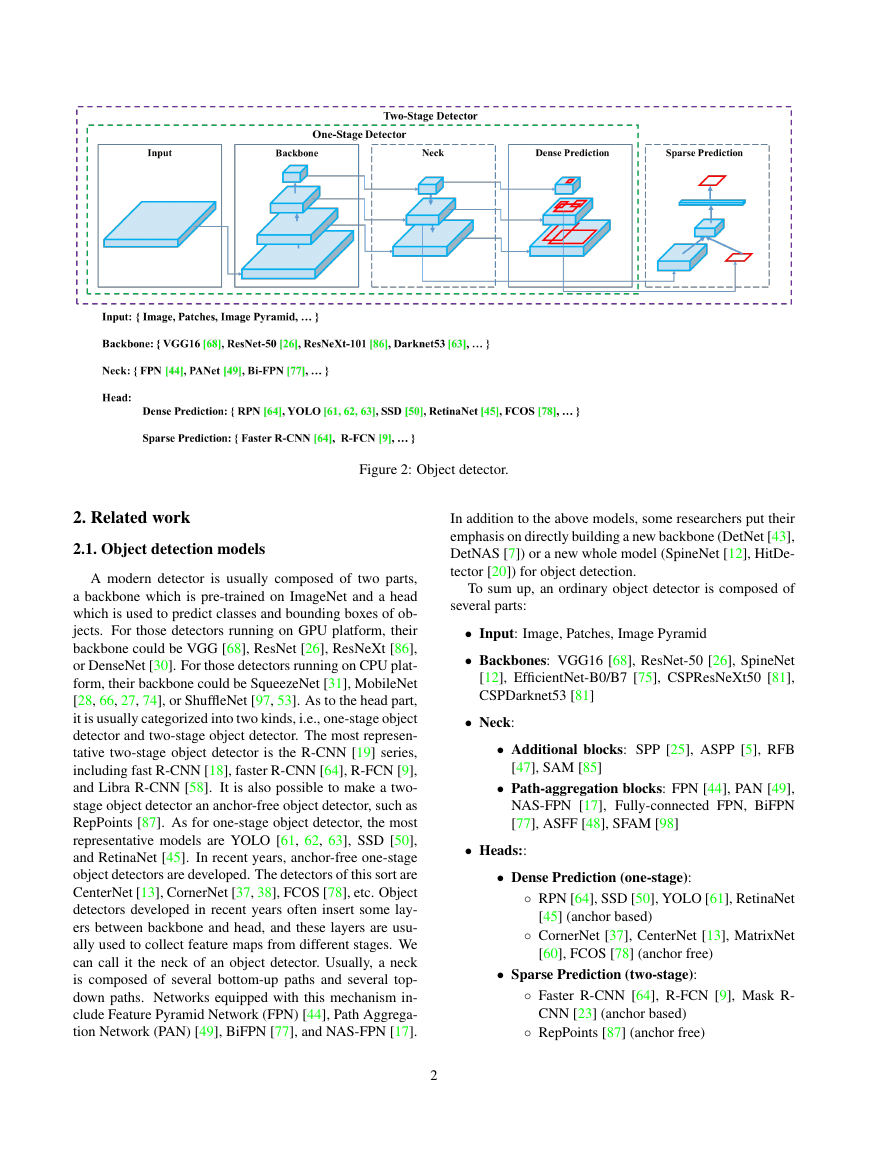

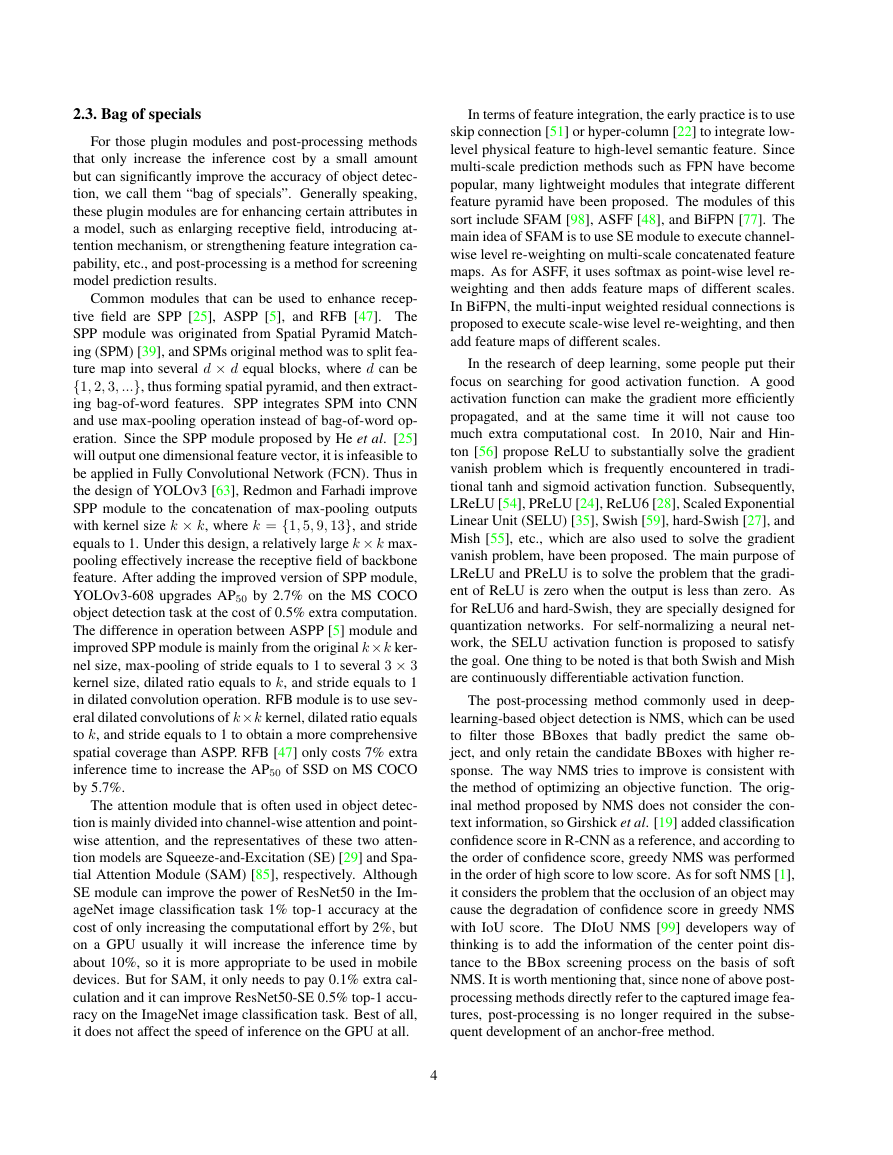
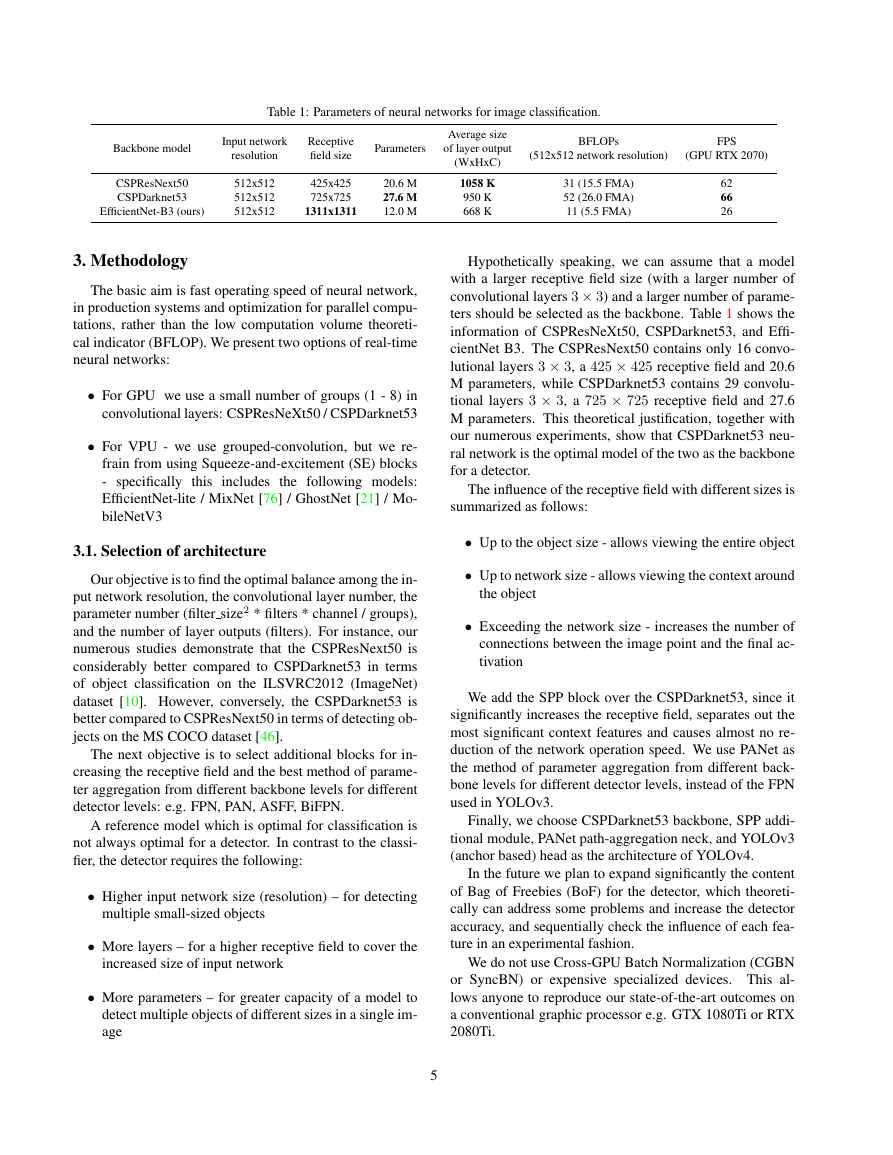
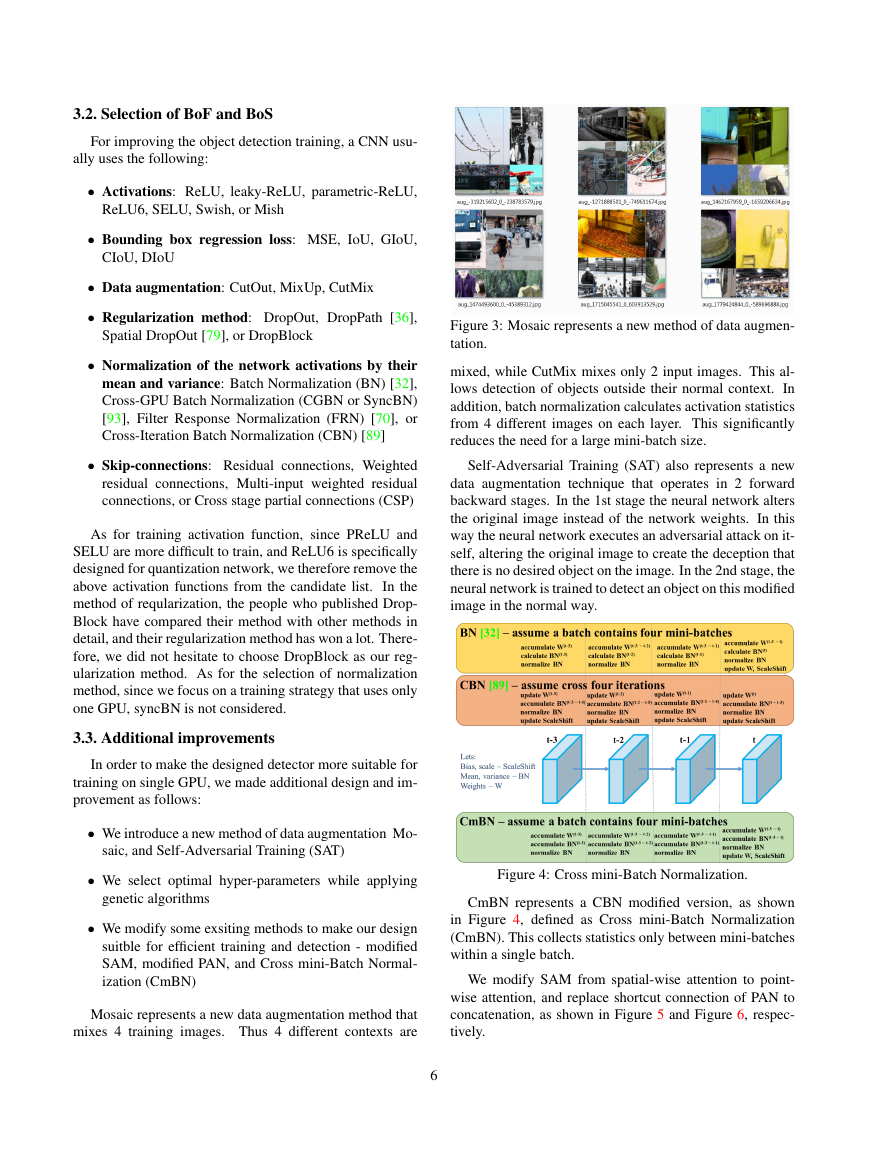
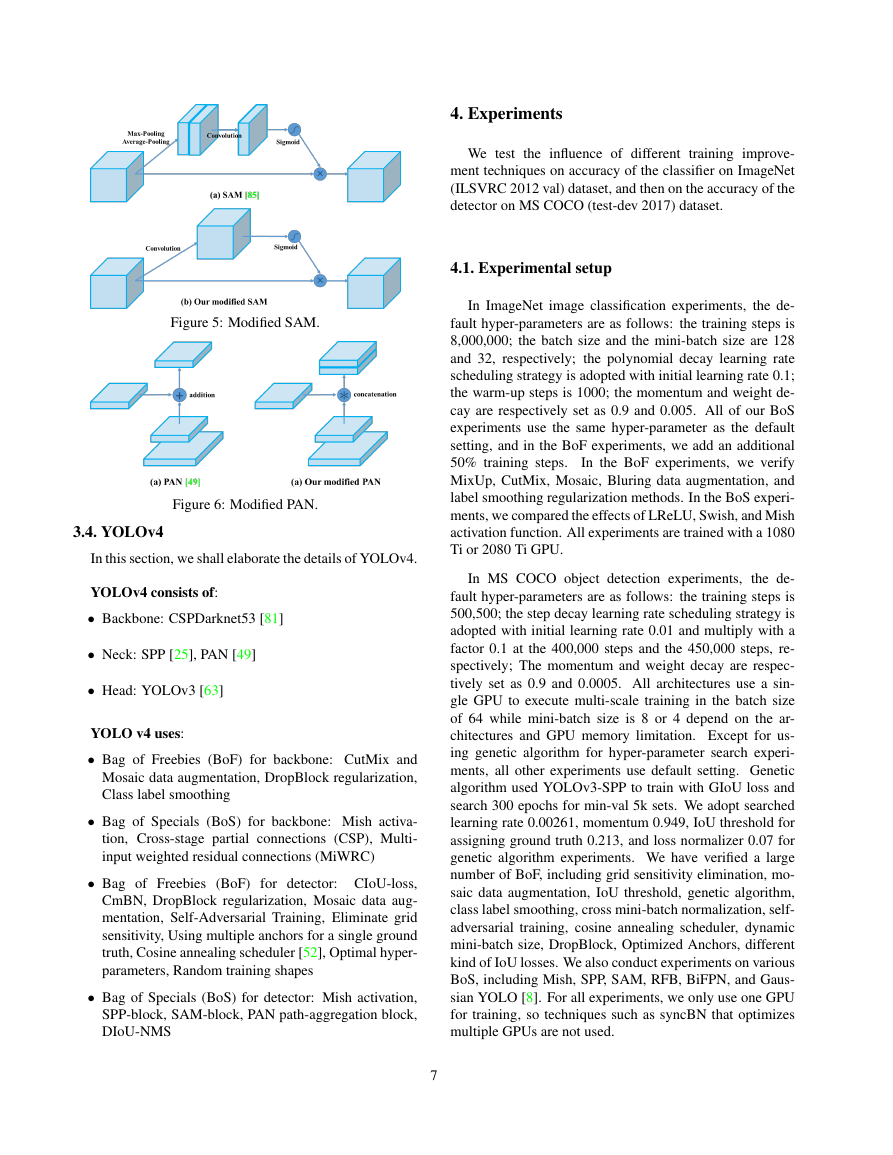
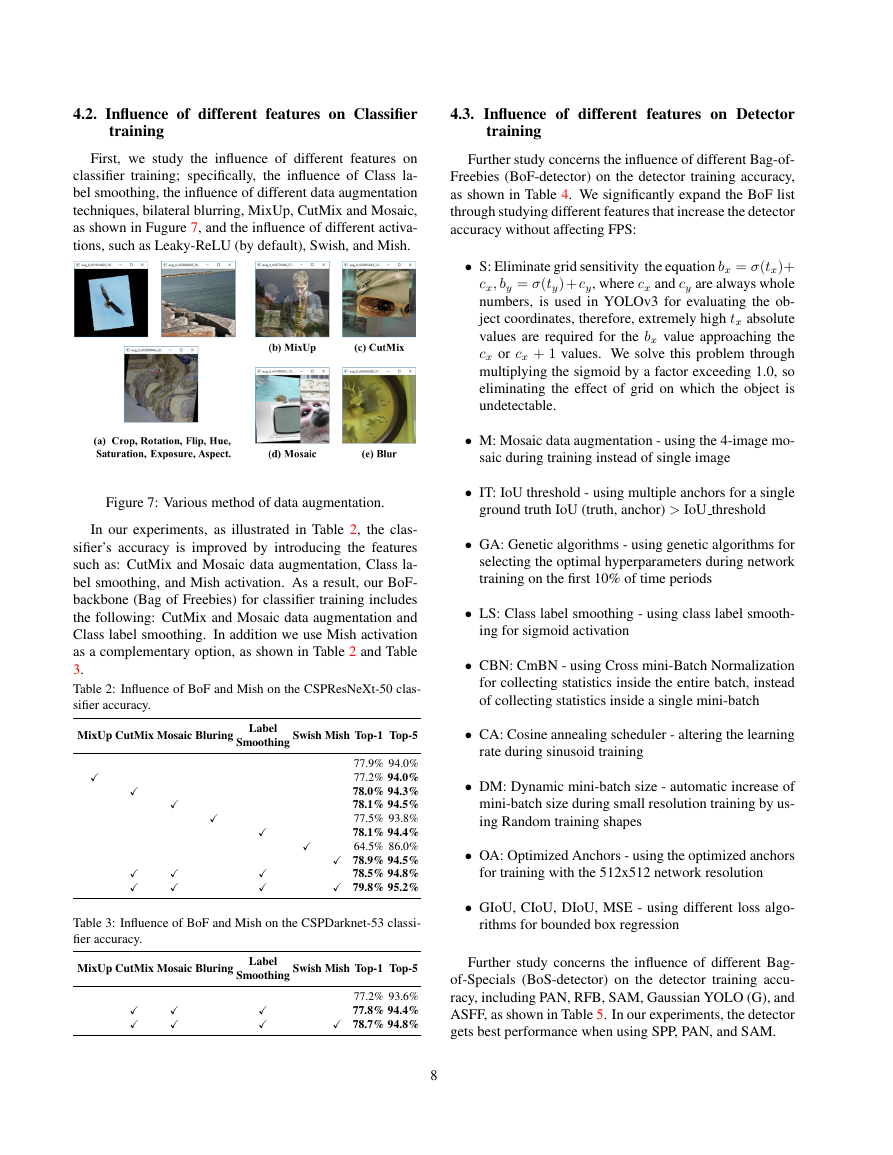








 2023年江西萍乡中考道德与法治真题及答案.doc
2023年江西萍乡中考道德与法治真题及答案.doc 2012年重庆南川中考生物真题及答案.doc
2012年重庆南川中考生物真题及答案.doc 2013年江西师范大学地理学综合及文艺理论基础考研真题.doc
2013年江西师范大学地理学综合及文艺理论基础考研真题.doc 2020年四川甘孜小升初语文真题及答案I卷.doc
2020年四川甘孜小升初语文真题及答案I卷.doc 2020年注册岩土工程师专业基础考试真题及答案.doc
2020年注册岩土工程师专业基础考试真题及答案.doc 2023-2024学年福建省厦门市九年级上学期数学月考试题及答案.doc
2023-2024学年福建省厦门市九年级上学期数学月考试题及答案.doc 2021-2022学年辽宁省沈阳市大东区九年级上学期语文期末试题及答案.doc
2021-2022学年辽宁省沈阳市大东区九年级上学期语文期末试题及答案.doc 2022-2023学年北京东城区初三第一学期物理期末试卷及答案.doc
2022-2023学年北京东城区初三第一学期物理期末试卷及答案.doc 2018上半年江西教师资格初中地理学科知识与教学能力真题及答案.doc
2018上半年江西教师资格初中地理学科知识与教学能力真题及答案.doc 2012年河北国家公务员申论考试真题及答案-省级.doc
2012年河北国家公务员申论考试真题及答案-省级.doc 2020-2021学年江苏省扬州市江都区邵樊片九年级上学期数学第一次质量检测试题及答案.doc
2020-2021学年江苏省扬州市江都区邵樊片九年级上学期数学第一次质量检测试题及答案.doc 2022下半年黑龙江教师资格证中学综合素质真题及答案.doc
2022下半年黑龙江教师资格证中学综合素质真题及答案.doc